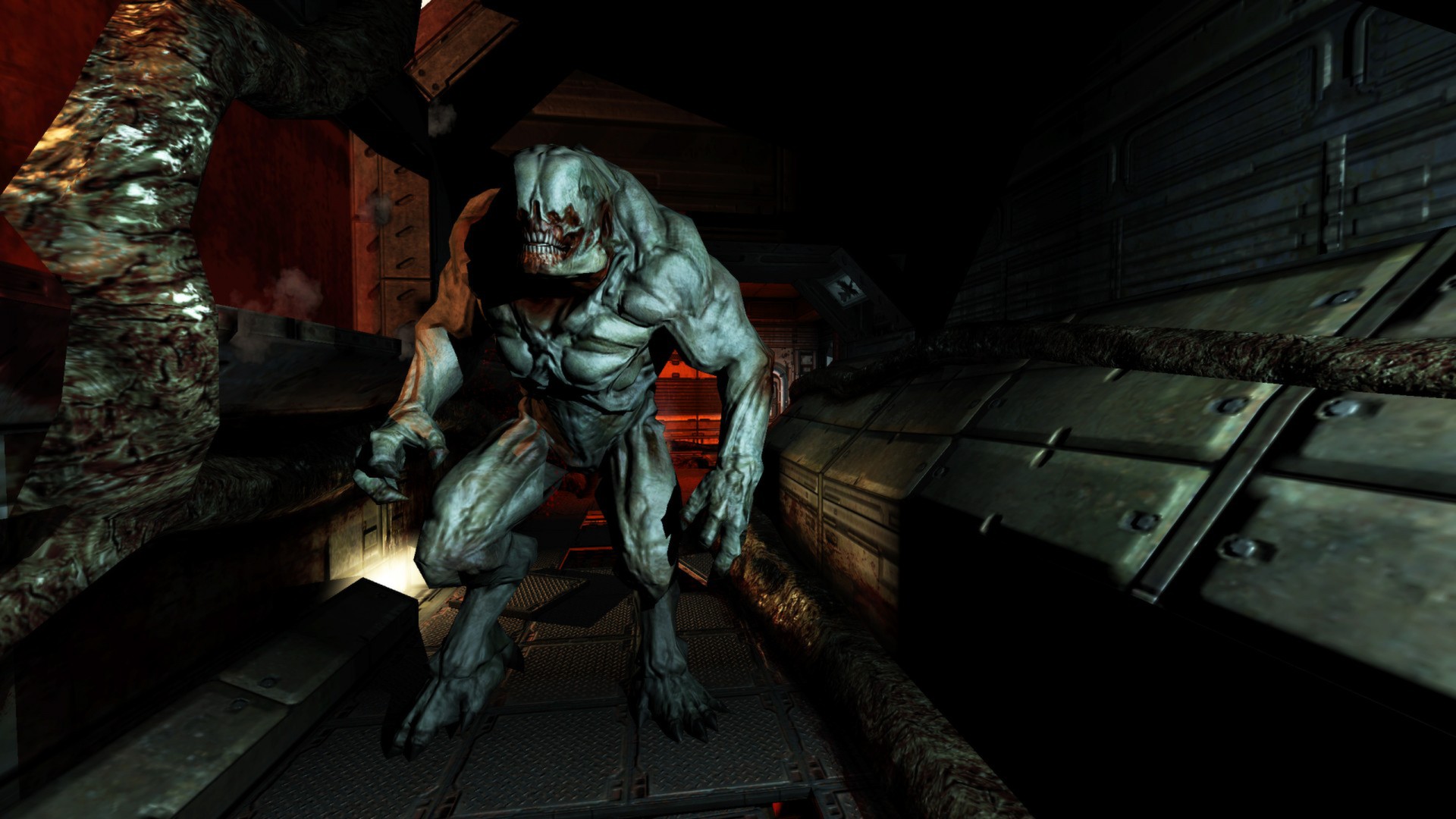
Doom 3’s reputation hasn’t changed all that much in the 20 years since its release. It has long been seen as a divisive departure from so many of the things that previously defined the Doom games. If anything, Doom 3’s reputation was solidified by 2016’s Doom: an almost universally beloved soft reboot of the series that reimagined the franchise’s breakneck action for a new age. When Doom 3 is discussed at all in this new era for the franchise, it is often referred to as the “other” Doom game or “that” Doom game.
That reputation is far from unearned. Doom 3 was, and remains, an anomaly. Like so many of the other anomalies in legacy franchises, though, Doom 3 has often been discussed and judged based on what it isn’t rather than what it is. That is why it is so misunderstood. For all of its faults and oddities, Doom 3 was an exceptional example of a particular kind of game that feels much easier to appreciate now that it is so hard to come by.
Doom 3 Was the Rare Remake Executives Didn’t Want
At a time when remakes and reboots are the only things that seemingly regularly get approved with a respectable budget, it’s hard to believe that Doom 3 began its life as the Doom remake that some of the top executives at developer id Software didn’t want.
They felt the studio had been relying on certain formulas for too long and was at risk of becoming stale during a time of great change for the FPS genre and the gaming industry as a whole. In their minds, a Doom remake would only solidify that perception. It was only after some of the studio’s most notable creative members (including Doom co-creator John Carmack) threatened to leave the company that id’s owners relented and allowed them to pursue a remake.
While the version of Doom 3 we got is technically a remake/reboot of Doom, it’s difficult to think of the game on those terms. That’s partially because of the game’s strange sequel-formatted name, but it’s largely because of those aforementioned changes to the franchise formula which suggest that id’s rebellious employees didn’t entirely get their way.
For instance, Doom 3 utilizes a more narrative-focused cinematic structure that feels closer to Half-Life than what we saw in the first two Doom games (or many of id’s other titles at that time). Doom 3 even begins with a softly guided “first day on the job” sequence that is strikingly similar to Half-Life’s famous opening. The game also featured third-person narrative-driven cutscenes: an anomaly even among the post-Half-Life PC shooters that Doom 3 was clearly inspired by.
Yet, its Doom 3‘s gameplay changes that drew the most jeers. Whereas the previous Doom games helped establish a fast-paced style now known as the “boomer shooter,” Doom 3 featured far less action and a generally slower pace. The majority of fights began with a monster jumping out of trigger-induced corners of the room (often referred to as “monster closets”) and descending upon the player. Even late in the game, Doom 3 relies on variations of that trick with often diminishing returns.
You still have access to the usual array of Doom weapons in Doom 3, but the playable protagonist is intended to be slightly weaker than the other “Doom Guy” iterations. That design philosophy is highlighted (some would argue lowlighted) by your character’s tendency to be knocked back whenever they take damage and an infamous flashlight mechanic that required you to lower your weapon to illuminate the game’s numerous pitch-black areas. The flashlight system was so reviled that fans quickly created a “duct tape mod” that both allowed you to carry a gun and light at the same time and effectively mocked the developers for creating such an obvious logic gap just to accommodate that core gameplay mechanic.
Most of those features serviced the Doom 3 team’s obvious desire to make a horror game. Not a first-person shooter with horror themes as the original Doom games were, but rather an outright horror title that attempted to deliver as much action as possible without compromising the scares. The developers intended for you to fear individual demons as much as the hordes of hell.
Yet, as Doom 3’s detractors were quick to point out, the game often felt like that combination of compromises that the early stages of its development suggest it may have very well been. The fact that you had to constantly make yourself vulnerable just to see where you were going speaks to the developer’s struggles to deliver such scares without relying on repetitious design.
It’s enough to make you wonder how Doom 3’s developers saw this as a remake of Doom and what drew them to that project in the first place. Yet, it’s when you seek the answers to those questions that you begin to realize that Doom 3 was exactly the game that its developers put their careers on the line for the chance to make.
What Makes a Doom Game a Doom Game?
Listen to Doom 3’s developers talk about the game, and you’ll quickly realize that the things they felt defined the original Doom are not necessarily the things most fans associated with that game and therefore expected from a project that was conceived as its remake.
Most notably, John Carmack and other key Doom 3 team members make a big deal out of wanting to use that title to push the limits of video game technology. It was the driving force behind the entire project, and it’s not hard to see why. Though the original Doom is known for many things, it was, in its day, a technical marvel that changed the internal and external perception of the industry. The team at id clearly felt their primary duty was to move video game technology forward. What better way to test such advanced technology than to reimagine the studio’s most important game in a modern engine to show people an undeniable example of how far the industry had come?
But if that was the main goal, then why was Doom 3 so different than what came before? Well, in some people’s minds, it really wasn’t all that different. In an interview with G4, John Carmack cited these qualities as the “tripod of features and technology that make Doom what it is:”
– Unified lighting and shadowing
– More complex animation and scripting
– The gooey surfaces that add an extra level of interactivity
When you look at the original Doom from that perspective, you see why Carmack and the rest of the Doom 3 team chose to make a horror title. If you were determined to feature those qualities, would you rather make an action game designed to be run through as quickly as possible or a horror game that emphasizes environmental exploration?
In that sense, the game is an almost undeniable success. Whatever else you may say about Doom 3, the fact of the matter is that many gamers, journalists, and developers of the early 2000s didn’t believe that Doom 3’s graphics were real until they played it. The game still looks shockingly “modern” to this day in terms of its visual design if not the raw visuals themselves.
Mind you, the Doom 3 team was aware that they were making something that was going to confuse and even anger some fans. Yet, they wanted to challenge themselves to develop an intense and technologically innovative experience that was going to recall the feeling of playing Doom for the first time without copying that game wholesale.
None of that is meant to shield the game from criticism or excuse its obvious faults. It’s just that understanding the kind of game the Doom 3 team was attempting to make is the key to appreciating the game we ended up with.
Doom 3 Is the Rare Horror Action Game That Balances Horror and Action
While the comparisons between Doom 3 and Half-Life are obvious and largely accurate, I’ve always found them to be a bit lazy. As a horror FPS title, Doom 3 has more in common with games like Condemned: Criminal Origins, F.E.A.R., Prey (2017), and BioShock. When you judge the game, it’s much more fair to compare and contrast it to those titles.
Mind you, all those games came out after Doom 3. There had been many FPS games with horror elements in them before Doom 3 (including the original Doom, obviously) and titles like System Shock had previously delivered what was essentially a horror game from a first-person perspective. Yet, even the titles that billed themselves as horror first-person shooters (such as Clive Barker’s Undying) typically utilized the very Doom-like style of FPS action that Doom 3 subverted.
Modern horror games make liberal use of the first-person perspective, but titles like Resident Evil 7 feel closer to the “survival horror” genre that many people tag Doom 3 with for want of a cleaner label. In reality, Doom 3 represents a more balanced blend of action and horror that was hard to come by in its day and is still largely limited to a handful of titles generally seen as underrated gems or anomalies.
And that’s a shame. For as much as I love horror gaming, it’s shockingly hard to find games that offer a fundamentally fun time while still feeling like true horror titles. Horror movies, horror TV shows, and horror books are comparatively blessed with such experiences, but horror game developers have historically felt that they need to lean in one direction or the other. Interestingly, one of the other games that find a balance between those concepts is the game that quickly surpassed Doom 3 in the minds of many: Half-Life 2. However, its successes in that arena are largely limited to the brilliant Ravenholm area of the game rather than the entire experience.
Doom 3 was different. At its best, Doom 3 gave you a gun and threw you into a haunted funhouse. Its scares were genuine (if sometimes cheap), but, much like Evil Dead 2 or Tremors, it featured a horror protagonist who was more than capable of standing up to some indescribable terrors without losing their underdog status. It’s a rare form of horror wish-fulfillment that understands that the experience of shooting the boogeyman is only satisfying if the boogeyman is effectively scary rather than a mere approximation of more effective creations in other works.
Sadly, Doom 3 wasn’t always at its best. It was often clunky, predictable, and sometimes felt closer to that technical showcase E3 attendees had once accused the game of being before they got to play it for themselves. With the release of Doom 3: BFG Edition in 2012, the developers caved to the most popular criticism and let you attach a flashlight to your gun. They also removed things like the ability to assign weapons to hotkeys in an attempt to keep the original game’s tension alive, but generally speaking, Doom 3 was finally closer to being the very Doom-like action game that many people wanted it to be from the start.
While there are parts of the BFG Edition I admire and even prefer, my heart belongs to the original version of the game, flashlight swapping and all. That’s the version of the game that tried something a bit different that deserved to be expanded upon despite the fact it didn’t entirely work out of the gate. Comparatively, the BFG Edition feels a bit closer to the original and modern Doom titles. Unfortunately, those other games do so many of the things that BFG Edition tries to do better than it possibly could.
Any good faith defense of Doom 3 shouldn’t try to argue that the game is perfect or that it isn’t fundamentally weird. It isn’t, and it is. 20 years later, though, it’s well past time to engage with Doom 3 on its own terms and recognize it as both a worthy entry in one of gaming’s greatest franchises and a game with unique qualities that should have inspired a wave of imitators rather than all-too-easy dismissals from that franchise’s fans. To this day, though, Doom 3 is arguably still the best example of what it was always meant to be.
The post 20 Years Later, Doom 3 Remains A Misunderstood Masterpiece appeared first on Den of Geek.






